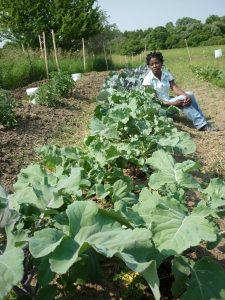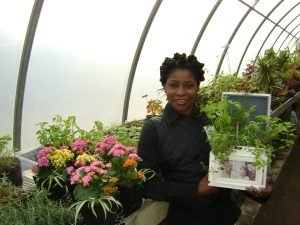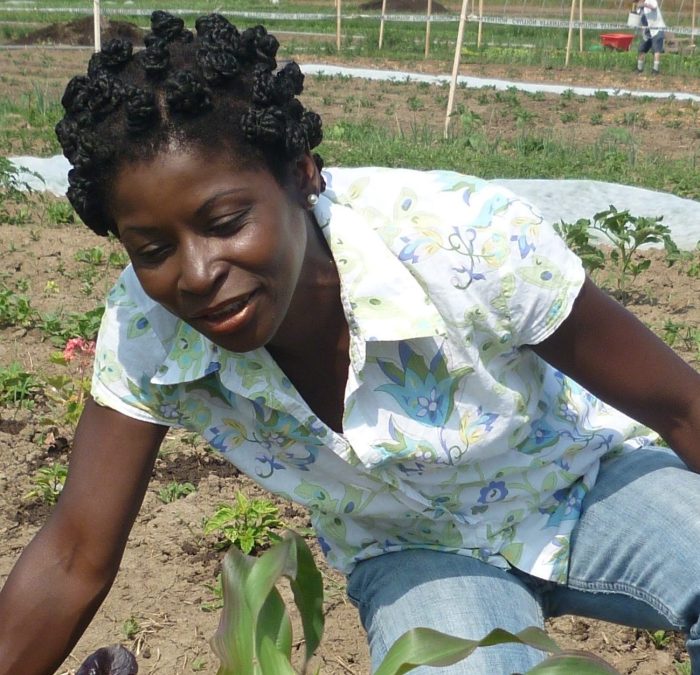Since 2011, Audrey McDonald has been growing organic vegetables, culinary herbs, tropical plants, and flowers at The Greenhouse Eatery on rented land in Brampton, Ontario.
Beyond growing vibrant Jamaican callaloo and marketing Greenhouse Eatery’s Garlic Bar products (including some seriously delicious black garlic!), Audrey is also dedicated to advocating for local foods and educating her community about their connection to the land. In this interview, we hear a little about how she became a farmer, the motivation behind her work, and her hopes for the future of agriculture.
Could you tell us a little bit about your farm journey? Describe the moment you realise you want to become a farmer.
I realised that I wanted to be a farmer after going through multiple career changes. I’ve done theatre, I’ve done fashion design. I’ve got culinary training, and I did social work. And I was always involved with environmental, agricultural, and growing projects in my community. From the latter, I won my community’s first green award, and received a Citizens Award of Merit by Michael Ignatieff, my MP, in 2010. I one day asked myself the questions: what did I like doing? What made me happy? What I was passionate about, what satisfied myself? And the answer was growing, farming, and the journey of the seed — those were all at top of the list. So, I started pursuing farming. And because I knew a lot about growing in the ground, I wanted to take the OMAFRA greenhouse course, because that was a completely different can of worms.
What drives your passion and inspires your work on the farm? When you think back, who are the people that were vital to your story, and provided you support throughout your journey?
Firstly, I must say that my biggest inspiration would be my grandmother. I’m an immigrant from Jamaica — it starts as a typical story of when your parents move away to a foreign land. My grandmother became my main caregiver. And it just so happened that she was also a farmer, and we had to move to her farm. Her farm had sort of a Mennonite model, where everyone contributes, regardless of age. I’m going to be honest with you, as a little girl, I really didn’t like it too much. But look where I am today!
 Why do you feel like it’s important to grow cultural crops? And what kind of relationships do you hope that people will build with these foods?
Why do you feel like it’s important to grow cultural crops? And what kind of relationships do you hope that people will build with these foods?
I’m passionate about watching the journey of the seed, growing and eating good food, sharing recipes, and educating young minds about where their food comes from. I am not in any way a band wagoner and I have been growing diverse, world crops since I started farming, as the Globe and Mail reported back in 2012. I have been experimenting with the viability of diverse crops in Canadian soil. It occurred to me that folks feel healthier, more comfortable, more at home, when they have access to their native foods. They are now astonished and excited that we can produce these crops locally here.
Can you give examples of the kinds of crops that you’ve experimented with, and found success with or were challenging?
It begins with some kind of vision. I tell myself to try new things all the time. During the process, I usually work the kinks out of it. Like with the Jamaican callaloo, for example. I knew if I wanted something out of that crop in the present season, that I’d have to start it in a greenhouse. The hot peppers, the pumpkins: I’d have to start in a greenhouse. And that’s because the growing season needed for these is so long. You can’t just plant them outside in May or June. By the time they start blooming, the frost is here.
When you started growing crops like callaloo, did you find that there were other farmers in Ontario doing the same kind of work?
When I went on FarmStart, there were 20 farmers, and some of them were my countrymen. I had the advantage of a greenhouse to grow in, and they were able to help me with pest control and irrigation needs. I was able to help them with time and crop planning. There was an exchange of knowledge.
What advice would you give to aspiring or new farmers?
Well, my first piece of advice that I would give is: please be aware that this is hard work. It’s trying work. You’re not in control here. Every season is different: one year you get flood, another drought. It’s like the relationship between the fisherman and the sea, except between a farmer and the weather. But remember, you’re not a solo artist. You’re gonna need help from friends and family, even the community. You’re not going to do this by yourself. You will also need passion and determination. And to the aspiring farmers of colour, especially those interested in growing cultural crops: You have to take the time to observe the Canadian climate, the growing season, and participate in that exchange of knowledge I mentioned earlier.
 What are your hopes for the future of local agriculture? And what kind of legacy do you hope to build?
What are your hopes for the future of local agriculture? And what kind of legacy do you hope to build?
I believe that I’ve built my legacy through sheer determination, vision, and passion. I am often imitated but never duplicated. For example, I was one of the first to bring local, fresh-cut tropical flowers to farmers markets, then other farmers followed suit. I was also the first to carry my niche baby root vegetables to market. Other farmers used to joke with me and say: “People buy that?” And then they started selling it as well. I was one of the first to carry Carribean crops to markets. And now white farmers grow these as well. Some people would prefer to go and buy that world crop from a white farmer than from the person who brought it to this country, or has the experience with it. They say we’re changing and we are making progress, but a lot is still swept under the carpet.
Is that something that you hope will change?
I think the younger generation has a different outlook. But the older generation, they are still looking through that lens. It’s like tunnel vision. This just proves to me that a person of colour will always have to work harder. The struggle is real. We also bring our preserves, jams or jellies, sauces, and we make jerk chicken live on the grill at markets. You know, it’s the only way for us to get ahead. It can be very challenging. I’ve had moments where I’ve had to throw “diplomacy” out the window. I don’t tend to get upset in people’s faces. But then, I’m considered a rebel just for speaking up! I don’t let it get me down though. I just want folks to know when things are not okay.
Do you feel like your work on the farm is a form of advocacy or activism?
Yes, I do. It starts with my community. When it comes to teaching young minds, I’ve been in the schools and I teach kids as young as kindergarten about environmental studies, encouraging good environmental stewardship, connections to the ecosystem, and knowing where your food comes from. I’ve been advocating for local foods like that. Accessible fresh food, not just secondhand food from a food bank, right? And to bring it back to land and the land connection, I ask a simple question: What’s wrong with growing food in an allotment, your yard, your neighbour’s yard? My message: grow food, not lawns.
How has the scene of agriculture changed since you started farming?
I think it has changed drastically. We now see a highly educated consumer, wanting to educate young minds about eating locally and knowing where your food comes from. They come with this attitude now. People bring their kids to market all the time, encouraging them to ask the farmers questions. Not to mention, a lot of people are now interested in growing their own food, even on a small scale. They strongly believe in supporting farmers. We also see more Indigenous farmers coming to market. We swap stories about growing the Three Sisters, we exchange seeds, and we exchange knowledge. Also, you now see a lot of younger farmers. And you know what’s funny? Whenever there’s a new, younger farmer at the market, they throw them beside me — don’t ask me why!

